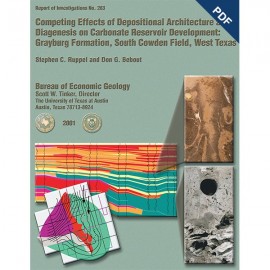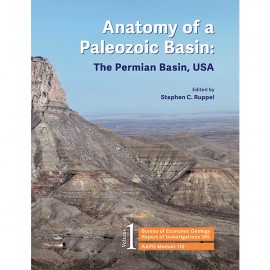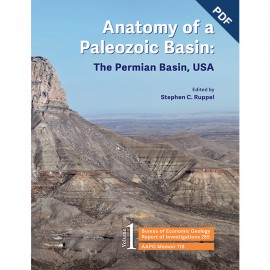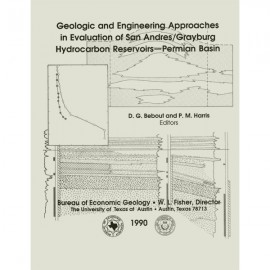Reports of Investigations
-
Books & Reports
- Reports of Investigations
- Guidebooks
- Udden Series
- Geological Circulars
- Down To Earth
- Atlases of Major Oil and Gas Reservoirs
- Texas Memorial Museum Publications
- Environmental Geologic Atlas of the Texas Coastal Zone
- Mineral Resource Circulars
- Other Reports
- Seminars and Workshops
- Handbooks
- Submerged Lands of Texas
- Symposia
- Annual Reports
- Open File Reports
-
Maps & Cross Sections
- Thematic Maps
- Miscellaneous Maps, Charts & Sections
- Geologic Atlas of Texas
- STATEMAP Project Maps
- Geologic Quadrangle Maps
- Cross Sections
- Highway Geology Map
- Energy and Mineral Resource Maps
- Shoreline Change and Other Posters
- Wilcox Group, East Texas, Geological / Hydrological Folios
- Bouguer Gravity Atlas of Texas
- River Basin Regional Studies
- Featured Maps
- Posters
- Teachers & the Public
-
Geological Society Publications
- Gulf Coast Association of Geological Societies
- Alabama Geological Society
- Austin Geological Society
- Corpus Christi Geological Society
- Houston Geological Society
- Lafayette Geological Society
- Mississippi Geological Society
- New Orleans Geological Society
- South Texas Geological Society
- GCS SEPM Publications
- Historic BEG & UT Series
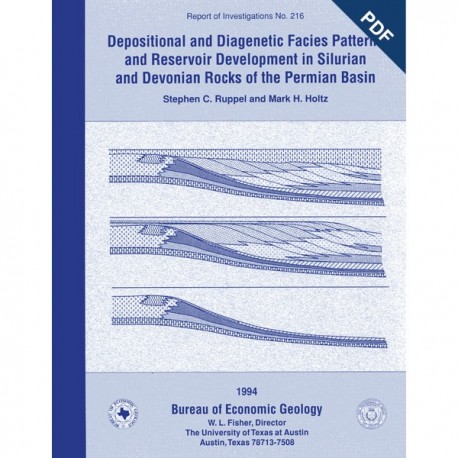
Depositional and Diagenetic Facies Patterns and Reservoir Development... in...Permian Basin. Digital Download
RI0216D
For a print version: RI0216.
RI0216D. Depositional and Diagenetic Facies Patterns and Reservoir Development in Silurian and Devonian Rocks of the Permian Basin, by S. C. Ruppel and M. H. Holtz. 89 p., 80 figs., 2 tables, 1 appendix, 1994. doi.org/10.23867/RI0216D. Downloadable PDF.
To purchase this publication in book format, please order RI0216.
ABSTRACT
Silurian and Devonian carbonate and chert rocks in the Permian Basin constitute a prolific hydrocarbon-bearing succession in West Texas and New Mexico. Production from nearly 650 reservoirs developed in these rocks totals almost 2 billion barrels of oil, and current estimates indicate that a similar amount of mobile oil remains in existing reservoirs. Recovery of this substantial resource hinges on a thorough understanding of the role depositional and diagenetic processes play in the development of reservoir heterogeneity. This report examines these processes and relates their distribution to stages and styles of basin evolution.
The lower part of the nearly 2,000-ft-thick carbonate succession comprises Upper Ordovician and Silurian rocks (Fusselman Formation) that were deposited on a stable, broad, low-gradient, shallow-water platform. These deposits are composed of a relatively simple suite of widespread shallow-water carbonates. Reservoirs develop principally in basal ooid grainstones and overlying pelmatozoan packstones, both of which are areally extensive. Porosity development is enhanced by diagenesis associated with high-frequency sea-level fall and exposure events during and following Fusselman deposition.
Drowning and downwarping of the platform during the middle Silurian caused considerable platform-to-basin relief and substantially greater facies diversity in the overlying Wristen Group. These carbonates include outer ramp-slope to basin mudstones (Wink and Frame Formations) and complex platform-margin and inner platform suites of shallow-water carbonates (Fasken Formation). Reservoirs in these rocks develop exclusively in platform-margin, coral/stromatoporoid-buildup successions and in cyclic and laterally variable inner platform facies. Porosity in inner platform rocks has been enhanced at the tops of high-frequency cycles by diagenetic leaching associated with periodic sea-level fall.
A major rise in sea level during the Early Devonian resulted in basin infilling, first by transgressive, slope/basin, spiculitic chert and then by progradational, highstand, skeletal carbonate. Reservoirs in these rocks (Thirtyone Formation) are developed in cherts whose distribution results from cyclic sea-level rise and fall and processes of gravity mass transport and in grain-rich carbonates that underwent leaching during regional Middle Devonian uplift.
On the basis of their geological setting, Silurian and Devonian reservoirs are grouped into four plays. An examination of engineering properties of the largest of these reservoirs resulted in the definition of ranges of variation for each play. Characterizations presented for each of the plays in this report thus provide models for the understanding and definition of geological and engineering reservoir properties as a basis for more efficient exploitation of the significant remaining resource in these rocks.
Keywords: basin evolution, depositional facies, Devonian, diagenesis, Fusselman Formation, New Mexico, oil reservoirs, Permian Basin, Silurian, Thirtyone Formation, West Texas, Wristen Group
Citation
Ruppel, S. C., and Holtz, M. H., 1994, Depositional and Diagenetic Facies Patterns and Reservoir Development in Silurian and Devonian Rocks of the Permian Basin: The University of Texas at Austin, Bureau of Economic Geology, Report of Investigations No. 216, 89 p. doi.org/10.23867/RI0216D.

